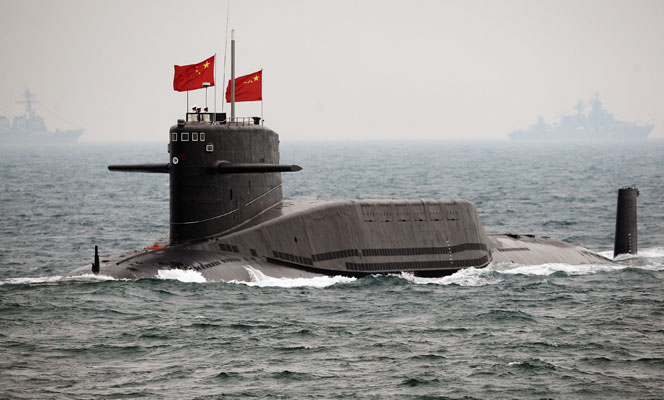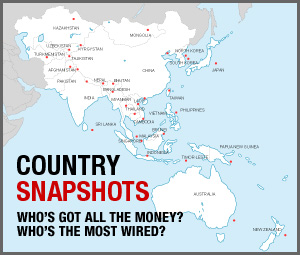The Next Arms Race

…will be undersea, say Toshi Yoshihara and James R. Holmes, and will have big political repercussions for the entire Asia-Pacific region.
A naval arms race is gathering pace in the Asia-Pacific. It will be unlike the competition that gripped Europe over a century ago, when the great powers sought to outdo each other in the number and tonnage of warships. Today, a major component of this maritime rivalry is taking place in the murky world of undersea warfare where, instead of the big-gun battleships that became the hallmark of the arms buildup prior to World War I, nations over the next decade will put to sea small, seemingly unassuming submarines.
As a result, neither gun size nor displacement will be accurate measures of sea power. Rather, Asian capitals will invest in the subtleties of hull design, propeller blades and propulsion systems that maximize stealth and endurance for the quiet hunter-killers. Current trends suggest that submarine warfare will emerge as a growth industry in Asia, becoming a defining feature of the regional military balance over the next decade.
So why pursue a submarine program? Essentially, submarines confer operational advantages that appeal to Asian naval planners. The submarine is the ideal platform for sinking merchant shipping and choking off maritime commerce. With most Asian nations dependent on seaborne trade, undersea warfare exploits the acute vulnerabilities of integrated economic systems. The unrestricted submarine warfare undertaken by the German and US navies (against Great Britain and Japan, respectively) during World War II exemplifies the potential of commerce raiding. Submarines also pose an enduring threat to warships. Used defensively, a picket line of subs could erect a no-go zone, effectively denying a hostile naval task force control of the seas. Employed offensively, attack submarines could clear a nautical area of enemy vessels as a prelude to its own exercise of sea control.
Additional strategic factors create further incentives for submarine development. Professional submariners proclaim that the best antisubmarine platform is another submarine. By that logic, navies often feel compelled to compete ‘symmetrically’ with prospective adversaries, matching their submarine build-ups on a one-for-one basis. Submarine competition can thus quickly degenerate into a zero-sum game over numbers, whereby numerical superiority for one side is perceived as a grievous disadvantage for its opponent. And since aircraft-carrier warfare is affordable only to an exclusive club of great powers, submarines offer weaker nations a financially sustainable option for exercising sea power–a capability that would otherwise remain out of reach. It’s unsurprising, then, that a cluster of submarine fleets is taking shape in the region.
The Russian Navy deploys the best-known submarine fleet indigenous to East Asia, if only because it’s the successor to the vaunted Soviet Pacific Fleet. In terms of raw numbers, the Soviet Navy possessed an astonishing undersea fleet–by the early 1970s, some 300 nuclear-powered attack submarines (SSNs) or nuclear guided-missile submarines (SSGNs) were in the Soviet naval inventory, along with 50 nuclear ballistic-missile submarines (SSBNs). For the sake of comparison, the entire US Navy numbered less than 500 vessels by the late 1970s, before the rebuilding effort of the 1980s.
On the other hand, Soviet submarines laboured under a variety of geographic, technical and human constraints. While quantity has a quality all its own, as Fleet Admiral Sergei Gorshkov liked to say (channelling Josef Stalin), numbers are not everything. The northern arc of the ‘first island chain’ encloses the Russian coast in East Asia, offering a hostile submarine force a ready-made defence perimeter. And indeed, Japanese and US antisubmarine forces made expert use of maritime geography. While Soviet boats outshone their Western antagonists in some respects–for example, they were ruggedly built, and thus were able to dive deeper–they were also noisy. As a result, they were relatively easy for Western sonar operators to hear. (One retired US submariner likened the noise levels emitted by early Soviet craft to two skeletons making love inside a metal trash can.)
The din of machinery, then, compromised stealth–the most critical attribute of any submarine. Moreover, the submarine force, like the rest of the Soviet Navy, suffered from a severe deficit in seamanship and skill compared to US and Japanese mariners. Not for nothing did Western submariners boast of how often they bested their Soviet counterparts in the cat-and-mouse game that comprised the Cold War at sea. This same litany of woes persists in the Russian Navy today. To use the three indices posited above, geographic obstacles are permanent. The Russian Pacific Fleet, such as it is, still must contend with an offshore island chain. From a material standpoint, the economic travails that followed the Cold War devastated the Russian navy. In fact, one component of US aid to Russia following the Soviet collapse helped dismantle Soviet nuclear submarines that were rusting pier side. The accidental sinking of the Oscar II-class SSGN Kursk in 2000 and last year’s deadly fire on board the Akula-class attack boat Nerpa–a vessel that was undergoing sea trials before being leased to India–constitute worrisome portents for Moscow.
So, despite the upswing in Russian economic prospects in this era of relatively high oil prices, it’s doubtful that the Russian Navy has yet recovered from the days when Russian sailors were reduced to selling uniform parts for food, as they were on occasion during the 1990s. Morale, engineering proficiency and tactical skill take time to rebuild after such traumas. And the Russian Pacific Fleet is now a shadow of its former self by material measures like numbers and capability. Of the 23 strategic and tactical submarines stationed at Pacific bases, 10 are laid up in reserve, while the material condition of even the active boats is dubious. Capt. Alfred Thayer Mahan, second president of the US Naval War College, wrote that an authoritarian government can create a great navy with impressive speed, but that the fleet could suffer rapid decay should the attention of that government wander. If Mahan is right, Russia will remain a secondary Pacific naval power for the foreseeable future.










